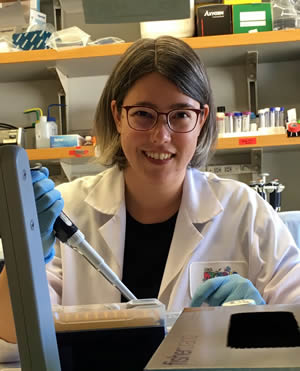Dr. Kathrin LeppekBy Chun Kim Posted: December 9, 2019
Dr. Kathrin Leppek has had a long-term interest in post-transcriptional gene regulation and is currently a post-doctoral researcher in Dr. Maria Barna’s lab at Stanford University. Dr. Leppek received her bachelor’s degree at the University of Heidelberg where she was first introduced to the world of RNA structural biology studying with Dr. Andreas Wachter “how TPP-sensing riboswitches and structured RNA elements in plants regulate alternative splicing and nonsense mediated decay.” During her graduate training, Dr. Leppek continued her research on RNA structural elements in the lab of Dr. Georg Stoecklin at the German Cancer Research Center (DKFZ) and Heidelberg University, where she discovered “how a class of conserved stem-loops, termed constitutive decay elements, in the 3’ UTR [untranslated region] of many mRNAs are selected for rapid decay, mediated by binding to Roquin proteins and deadenylation.”
A biochemist by training, Dr. Leppek has a passion for developing and applying RNA techniques to different model systems, and the opportunity to apply this passion drew her to the Barna lab. “By the end of my relatively short Ph.D.,” Dr. Leppek said, “I knew I wanted to stick to investigating functional RNA structures, but I was open to new biological questions and model systems. I particularly remembered a fascinating paper from the Barna lab about the role of ribosome heterogeneity in development. The fearlessness and creativity of her work, the out-of-the-box thinking, and the diverse mix of scientists drew me in.”
Currently, Dr. Leppek is interested in how the ribosome itself can have a role in regulating gene expression. She explained, “As one of the first molecules on earth, ribosomal RNA (rRNA) has long been known to perform the core job of the ribosome: peptide bond formation. But the possible contribution of rRNA to regulation of translation, organismal development and evolution has long been overlooked. In particular, rRNAs contain many portions of extended RNA fingers—so-called expansion segments (ESs)—that stick out of the surface like tentacles.” These finger-like segments are also highly variable between species, and Dr. Leppek discovered that these variable regions are customized according to the specific needs of the species, recently finding that an expansion segment in the 40S subunit can directly bind to select mRNA 5’ UTRs to regulate their translation. “In other words,” she said, “rRNA ES regions are not just ‘junk RNA’ on the ribosome, but may have evolved to customize the ribosome according to the needs of a species to translate their given transcriptome.”
Dr. Leppek reflected that she has “always been driven by an interesting biological question that kept me going every day, and developed methods along the way if they haven’t been invented yet.” But, she emphasized, “data don’t lie, and more than once I was lead in an unexpected direction by new results. Sometimes you have to do the killer experiment that may shatter your hypothesis, but it will lead to a new one. So be brave and challenge your expectations—the sooner you do it, the sooner you will know the answer.”
Dr. Leppek is also an active member in her local scientific community, forming a coalition of post-doctorate fellows to support the organization of the Bay Area RNA Club (BARC). With her help, the Bay Area RNA Club has incorporated mentor lunches with academic and industry contacts to provide networking opportunities for its members. “I have particularly enjoyed working with fellow female postdocs on the logistics of organizing a scientific meeting, which are very different from our everyday tasks,” she said. “Together, we have implemented a lot of positive changes to the symposium including ensuring that all the junior talks were well-balanced with regard to gender representation. In fact, there was even a majority of female speakers this year!”
Dr. Leppek is “fascinated by people who made discoveries in their field and persisted, even though these discoveries might only have been appreciated decades later.” She especially draws inspiration from many scientists in the RNA community, including Dr. Ron Breaker, the late Dr. Elisa Izaurralde, and her current mentor, Dr. Barna. She continued, “The RNA field is lucky to have many female scientists who are giants in their field. My all-time heroines are Dr. Joan Steitz and Dr. Jennifer Doudna for their ground-breaking discoveries in basic RNA biology that have influenced how all of us do science today. And I am still star-struck every time I attend their talks!”
Dr. Leppek’s current favorite RNA is 18S rRNA, but she is fascinated by all functional RNA structures in the 5’ or 3’ UTR—“the 5’ and 3’ UTRs are my happy place.” Dr. Leppek’s research can be followed @KatLeppek on twitter. She also runs the Barna lab account @mbarnalab. |

